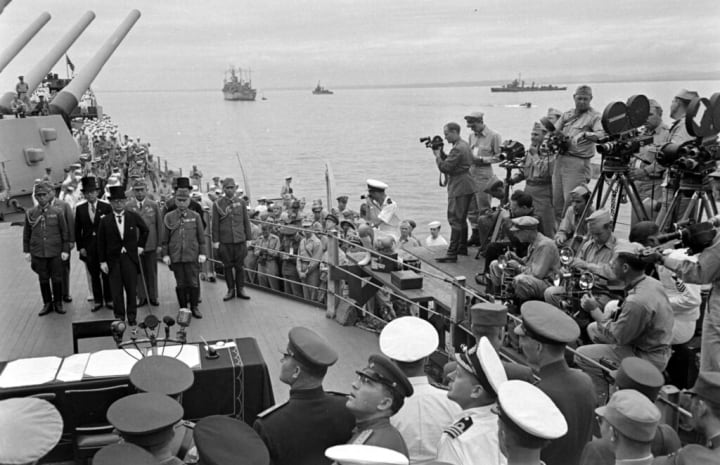Beyond Surrender
The Untold Stories of Japanese Holdouts

Introduction: Echoes of Conflict
The Pacific Theater of World War II was a battleground etched with brutality and unwavering resistance. Its echoes lingered long after the war officially concluded in 1945. Beyond the signed treaties and the proclaimed end of hostilities, a profound tale emerged—one that unveiled the committed resolve of Japanese soldiers who continued their fight far beyond the cessation of warfare.
These individuals and small groups known as “holdouts,” clung to remote jungles and islands in the Pacific, entrenched in a reality where the war persisted despite the world moving on. Their steadfast commitment to duty and an ingrained sense of honour compelled them to persist in isolation, resisting acceptance of Japan’s surrender.
The Roots of Resilience: A Culture Forged in Loyalty
The holdouts’ resilience stemmed from a complex combination of factors deeply rooted in Japanese military culture. They were indoctrinated in absolute loyalty and unwavering obedience, fostering an unparalleled sense of duty. Trained to fight until death and never surrender, these principles became intrinsic to their identity. Furthermore, the isolation of the Pacific islands, coupled with the limited communication channels during the war, perpetuated their belief in an ongoing conflict, fueling their determination to continue fighting.

Survival Tactics: The Unyielding Spirit Amidst Adversity
Amidst the dense jungles and desolate islands, survival became their ultimate battle. These holdouts mastered the art of endurance, living off the land with limited resources. Coconuts, taro, wild sugar cane, and whatever nature provided sustained their existence. Crafting networks of underground tunnels, they navigated their hiding places with stealth, evading detection and surviving against all odds. Their resilience was a testament to the human spirit's ability to adapt, endure, and persist in the most challenging circumstances.
Continued Combat: The Unending Struggle
Even as the world moved towards reconstruction post-World War II, the Japanese holdouts persisted in their solitary battles. Engaging in prolonged combat against local authorities and Allied forces, they remained steadfast in their belief that the war persisted. Even before the official end of the war on Pacific Islands where the Allied forces had already defeated the Japanese defenders, groups of holdouts would emerge. On Guam in 1944, a joint American-Guamanian force tirelessly sought out thousands of Japanese holdouts. The ensuing clashes dwindled their numbers from thousands to just a handful.
Hiroo Onoda: The Unyielding Lieutenant
Among the most renowned holdouts was Hiroo Onoda, a lieutenant stationed on the Philippine island of Lubang. For nearly three decades after the war’s end, Onoda waged a solitary guerrilla war, steadfast in his conviction that Japan had not surrendered. His unwavering devotion to his orders blinded him to the truth, sustaining his belief in an ongoing conflict. In a momentous turn, his former commanding officer, Major Yoshimi Taniguchi, journeyed to Lubang in 1974, persuading Onoda to finally lay down his arms after 29 years of guerrilla warfare.
Shoichi Yokoi: A Decades-Long Solitude
Similar to Onoda, Shoichi Yokoi found himself hidden in the jungles of Guam for 28 years post-war. Yokoi's unwavering belief in the deception of Japan's surrender led him to a cave where he subsisted on meagre resources from the wild. Discovered by Guamanian residents in 1972, Yokoi's return to society bore witness to a world he thought had vanished. His story reflected the enduring struggle of an individual caught between duty and an altered reality.

Yamakage Kufuku and Matsudo Linsoki: Prolonged Resistance on Iwo Jima
On Iwo Jima, the legacy of resistance endured through the prolonged fight of Yamakage Kufuku and Matsudo Linsoki, two Imperial Japanese Navy machine gunners. Discovered in 1949, they defied the end of the war, persisting in their resistance for over three years. Their written account in 1968 further unveiled the intricacies of their prolonged struggle against an acknowledged defeat.
The Lasting Impact: Echoes of Conflict
The discovery of holdouts post-war resonated as a poignant reminder of the war's enduring legacy. Their refusal to surrender, despite the passage of time and formal declarations of peace, echoed the deep-seated values of duty and honour instilled within them. However, their prolonged resistance bore witness to a conflict that persisted beyond the official end, leaving an indelible mark on the landscape of war history.
Notable Japanese Holdouts Found Post-WWII
The discovery of Japanese holdouts post-World War II unveiled a lingering tale of individuals steadfastly clinging to their beliefs. These soldiers, unaware or unconvinced of Japan's surrender, endured for varying durations in remote locations across Southeast Asia and the Pacific islands. Here is a compilation of some of the notable holdouts and the dates they were found:
Yamakage Kufuku and Matsudo Linsoki
Date Found: January 6, 1949
Duration since WWII end: 3 years, 130 days
Location: Iwo Jima
Summary: Yamakage Kufuku and Matsudo Linsoki, two Imperial Japanese Navy machine gunners, surrendered on Iwo Jima. Their names became known when they co-wrote a book in 1968 about their experiences.
Yūichi Akatsu
Date Found: March 1950
Duration since WWII end: 4 years, 210 days
Location: Lubang, Philippines
Summary: Private 1st Class Yūichi Akatsu continued to fight on Lubang Island in the Philippines from 1944 until surrendering in the village of Looc in March 1950.
Murata Susumu
Date Found: 1953
Duration since WWII end: 8 years, 120 days
Location: Tinian, Mariana Islands
Summary: Murata Susumu, the last holdout on Tinian, was captured in 1953.
Shōichi Shimada
Date Found: May 1954
Duration since WWII end: 8 years, 271 days
Location: Lubang, Philippines
Summary: Corporal Shōichi Shimada, who was holding out with Lt. Onoda, continued to fight on Lubang until he was killed in a clash with Filipino soldiers in May 1954.
Noboru Kinoshita
Date Found: November 1955
Duration since WWII end: 10 years, 89 days
Location: Luzon, Philippines
Summary: In November 1955, Seaman Noboru Kinoshita was captured in the Luzon jungle, but shortly afterwards committed suicide by hanging himself rather than "return to Japan in defeat."
Bunzō Minagawa
Date Found: May 1960
Duration since WWII end: 14 years, 261 days
Location: Guam
Summary: Private Bunzō Minagawa held out from 1944 until May 1960 on Guam.
Masashi Itō
Date Found: May 23, 1960
Duration since WWII end: 14 years, 264 days
Location: Guam
Summary: Sergeant Masashi Itō, Minagawa's superior, surrendered days later, May 23, 1960, on Guam.
Shoichi Yokoi
Date Found: January 1972
Duration since WWII end: 26 years, 151 days
Location: Guam
Summary: In January 1972, Sergeant Shoichi Yokoi, who served under Masashi Itō, was captured on Guam.
Hiroo Onoda
Date Found: March 1974
Duration since WWII end: 28 years, 210 days
Location: Lubang, Philippines
Summary: In March 1974, Lieutenant Hiroo Onoda surrendered on Lubang after holding out on the island from December 1944 with Akatsu, Shimada and Kozuka. Onoda refused to surrender until he was relieved of duty by his former commanding officer, Major Yoshimi Taniguchi, who was flown to Lubang to formally relieve Onoda.
Teruo Nakamura
Date Found: December 18, 1974
Duration since WWII end: 29 years, 107 days
Location: Morotai, Indonesia
Summary: Private Teruo Nakamura (Amis: Attun Palalin), an Amis aborigine from Taiwan and member of the Takasago Volunteers, was discovered by the Indonesian Air Force on Morotai, and surrendered to a search patrol on December 18, 1974. Nakamura, who spoke neither Japanese nor Chinese, was the last confirmed holdout.
The information from the section above was gathered from Wikipedia's entry on Japanese Holdouts.

Rumours and Post-1970s Attempts to Locate Further Hideouts
Even after the last verified holdout surrendered in 1974, rumours and alleged sightings persisted, hinting at the possibility of lingering Japanese soldiers hidden in remote regions. Reports, though largely unsubstantiated, fueled attempts to locate these elusive figures well into the 21st century:
Numerous rumours circulated, hinting at possible holdouts on various islands. These reports led to extensive search efforts, including:
Vella Lavella, Solomon Islands (1981): Newspaper reports suggested holdouts still lived in the forests of Vella Lavella. However, subsequent investigations hinted at potential hoaxes orchestrated to attract Japanese tourists, casting doubt on the authenticity of these claims.
Kolombangara, Guadalcanal, and the Philippines (1992-2005): Alleged sightings and reports of holdouts triggered search operations. Investigations on Kolombangara and Guadalcanal failed to produce evidence, while two elderly men emerged from the Philippine jungle in 2005, claiming to be ex-soldiers. However, suspicions arose regarding the credibility of this account, as the individuals vanished afterwards amid concerns of a hoax or a kidnapping attempt.
Despite persistent rumours and sporadic reports, the status of any legitimate Japanese holdouts remains uncertain in recent times.
Ethical Dilemmas: Unraveling the Narrative
The narratives of the holdouts often evoke ethical quandaries, prompting contemplation on the nature of allegiance and honour. Their unwavering dedication, while rooted in deeply ingrained values, raises questions about the blurred lines between steadfastness and the evolving reality of a post-war world. These stories challenge conventional understandings of wartime duty, inviting reflections on the complexities of individual convictions in times of conflict.
Modern Echoes: Relevance in Contemporary Context
The stories of the Japanese holdouts continue to hold relevance in contemporary dialogues surrounding conflicts and loyalties. Their protracted resistance finds echoes in modern-day contexts, shedding light on instances where individuals or groups persist in conflict despite formal resolutions. These parallels compel us to reflect on the enduring nature of ideological allegiance and its ramifications in present-day conflicts worldwide.
The narrative of the Japanese holdouts in the Pacific constitutes a captivating chapter in World War II history, resonating as a testament to the unyielding human spirit in the face of adversity.
Conclusion: The Enigmatic Legacy Endures
The tales of the Japanese holdouts linger as an enigmatic yet profound chapter in the annals of World War II. Their unwavering resilience, nurtured by an unshakable sense of duty and honour, transcended the boundaries of time and conflict. Their prolonged resistance, rooted in a bygone era, challenges our understanding of wartime allegiance and the enduring impact of cultural ideologies.
These individuals, hidden in the isolated jungles and remote islands, stood as silent sentinels, embodying the indomitable human spirit's capacity to endure against insurmountable odds. Their stories, while perplexing in their persistence, offer a poignant reflection on the complexities of human conviction and the deep-seated values that transcend the constraints of war.
The legacy of the Japanese holdouts remains an enduring testament to the human spirit's resilience, urging us to contemplate the depths of commitment and the enduring echoes of conflict long after the last shots have faded into history.
About the Creator
Richard Clements
Unearthing the Mysteries of History, Crime, and the Unknown
Delve into the captivating world of history, crime, and mystery through factual writing. Explore the past, unravel human behavior, and solve enigmas.
Enjoyed the story? Support the Creator.
Subscribe for free to receive all their stories in your feed. You could also pledge your support or give them a one-off tip, letting them know you appreciate their work.






Comments
There are no comments for this story
Be the first to respond and start the conversation.